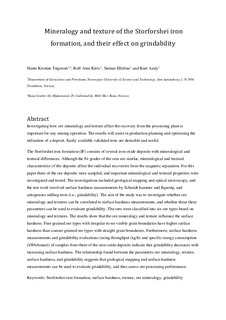| dc.contributor.author | Tøgersen, Marte Kristine | |
| dc.contributor.author | Kleiv, Rolf Arne | |
| dc.contributor.author | Ellefmo, Steinar Løve | |
| dc.contributor.author | Aasly, Kurt | |
| dc.date.accessioned | 2019-02-28T14:34:13Z | |
| dc.date.available | 2019-02-28T14:34:13Z | |
| dc.date.created | 2018-06-18T09:26:41Z | |
| dc.date.issued | 2018 | |
| dc.identifier.citation | Minerals Engineering. 2018, 125 176-189. | nb_NO |
| dc.identifier.issn | 0892-6875 | |
| dc.identifier.uri | http://hdl.handle.net/11250/2588110 | |
| dc.description.abstract | Investigating how ore mineralogy and texture affect the recovery from the processing plant is important for any mining operation. The results will assist in production planning and optimising the utilisation of a deposit. Easily available validated tests are desirable and useful.
The Storforshei iron formation (IF) consists of several iron oxide deposits with mineralogical and textural differences. Although the Fe grades of the ores are similar, mineralogical and textural characteristics of the deposits affect the individual recoveries from the magnetic separation. For this paper three of the ore deposits were sampled, and important mineralogical and textural properties were investigated and tested. The investigations included geological mapping and optical microscopy, and the test work involved surface hardness measurements by Schmidt hammer and Equotip, and autogenous milling tests (i.e., grindability). The aim of the study was to investigate whether ore mineralogy and textures can be correlated to surface hardness measurements, and whether these three parameters can be used to evaluate grindability. The ores were classified into six ore types based on mineralogy and textures. The results show that the ore mineralogy and texture influence the surface hardness. Fine-grained ore types with irregular-to-no visible grain boundaries have higher surface hardness than coarser-grained ore types with straight grain boundaries. Furthermore, surface hardness measurements and grindability evaluations (using throughput (kg/h) and specific energy consumption (kWh/tonne)) of samples from three of the iron oxide deposits indicate that grindability decreases with increasing surface hardness. The relationship found between the parameters ore mineralogy, texture, surface hardness, and grindability suggests that geological mapping and surface hardness measurements can be used to evaluate grindability, and thus assess ore processing performance. | nb_NO |
| dc.language.iso | eng | nb_NO |
| dc.publisher | Elsevier | nb_NO |
| dc.rights | Attribution-NonCommercial-NoDerivatives 4.0 Internasjonal | * |
| dc.rights.uri | http://creativecommons.org/licenses/by-nc-nd/4.0/deed.no | * |
| dc.title | Mineralogy and texture of the Storforshei iron formation, and their effect on grindability | nb_NO |
| dc.type | Journal article | nb_NO |
| dc.type | Peer reviewed | nb_NO |
| dc.description.version | acceptedVersion | nb_NO |
| dc.source.pagenumber | 176-189 | nb_NO |
| dc.source.volume | 125 | nb_NO |
| dc.source.journal | Minerals Engineering | nb_NO |
| dc.identifier.doi | 10.1016/j.mineng.2018.06.009 | |
| dc.identifier.cristin | 1591769 | |
| dc.description.localcode | © 2018. This is the authors’ accepted and refereed manuscript to the article. Locked until 14.6.2020 due to copyright restrictions. This manuscript version is made available under the CC-BY-NC-ND 4.0 license http://creativecommons.org/licenses/by-nc-nd/4.0/ | nb_NO |
| cristin.unitcode | 194,64,90,0 | |
| cristin.unitname | Institutt for geovitenskap og petroleum | |
| cristin.ispublished | true | |
| cristin.fulltext | postprint | |
| cristin.qualitycode | 2 | |

